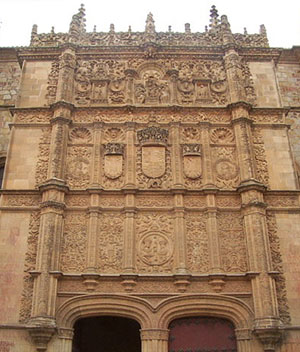Salamanca
|
|
- For other places named Salamanca, see Salamanca (disambiguation).
Salamanca-plaza.jpg
Salamanca (population 156,006 (2002)) is a city in central Spain, the capital of the province of Salamanca in the autonomous community of Castile-Leon. It formed part of the Kingdom of Leon.
The city lies on a plateau by the Tormes river, which is crossed by a bridge 500 ft long built on 26 arches, fifteen of which are of Roman origin, while the remainder date from the 16th century.
A central place in the city, the Plaza Mayor (illustration, above right), surrounded by shaded arcades, is known as the living room of the Salmantinos (Salamancans). It was constructed by Andres Garcia de Quifiones at the beginning of the 18th century; it would hold 20,000 people, once to witness bullfights, today to attend a concert, and is one of the finest squares in Europe. Salamanca is considered to be one of the most spectacular Renaissance cities in Europe. Through the centuries the sandstone buildings have gained an exquisite golden glow that has given Salamanca the nickname La Dorada, the golden city.
The old Romanesque cathedral (illustration, left) was founded in the 12th century. The dome that covers its crossing springs from a double arcade that is daringly pierced with windows, a distant reflection of Hagia Sophia. The mass of four pinnacles at the outside corners counter the thrust of the dome's weight. The thrust of the vaulting is borne by four massive pinnacles. The vault of the apse was frescoed by the Early Renaissance painter Nicolas Florentino. The adjoining "new" cathedral was built in stages from 1509 and combines Late Gothic architecture, particularly in the interior, with the Renaissance style called Plateresque. It was still being finished in 1734. In the treasury is the bronze crucifix that was carried into battle before El Cid.
In 1218, Alfonso IX of Castile and León founded the first Christian university in Iberia here, the university, (illustration, right), which is regaining some of the prestige it lost under Franco, Salamanca having been a bastion of his supporters. Under the patronage of the learned Alfonso X, its wealth and reputation greatly increased (1252-1282), and its schools of canon law and civil law attracted students even from the Universities of Paris and Bologna. At the height of the university, in the 16th century, one in five of Salamanca's residents was a student, and the city's fortunes depended on those of the university. About the time Christopher Columbus was lecturing there on his discoveries, Hernan Cortés took classes at Salamanca, but returned home in 1501 at age 17, without completing his course of study, looking for something to do. (About ten years later the conquistador Francisco Vásquez de Coronado was born in the city.) Miguel de Unamuno was a student here as was Miguel de Cervantes. Ignatius Loyola, while studying at Salamanca in 1527, was brought before an ecclesiastical commission on a charge of sympathy with the alumbrados, but escaped with an admonition. In the next generation St John of the Cross studied at Salamanca and so did the poet and writer Mateo Aleman.
The Augustinian monastery contains the tomb of the count and countess de Monterey, by Alessandro Algardi.
In the Peninsular War of the Napoleonic campaigns, the Battle of Salamanca, fought July 22, 1812,was a serious setback for the French, and a mighty setback for Salamanca, whose western quarter was seriously damaged.
The city is large enough to be able to offer the advantages of a real city, but at the same time it keeps the intimacy of a village. Since 1923, "Los Charros" formally the Union Deportiva Salamanca, have been the Salamanca football team from Salamanca.
In Salamanca, the inhabitants are said to speak the "purest" Spanish of Spain, Castilian, a reputation it shares with Valladolid. For this reason Salamanca is popular with people all over the world who want to learn Spanish.
Since 1996 Salamanca has been the designated site of the archive of the Spanish Civil War (Archivo General de la Guerra Civil Española). This archive was assembled by the Francoist regime, selectively obtained from the administrative departments of various institutions and organizations during the Spanish Civil War as a repressive instrument used against all sort of opposition groups and individuals: republicans of all signs, unionists, Communists, liberals, Freemasons, Basque and Catalan nationalists, etc. [1] (http://www.mcu.es/archivos/jsp/plantillaAncho.jsp?id=64)
In 2002 Salamanca shared with Bruges the title of European Capital of Culture.
The classic dish of the Salamancan Charreria or "peasant lands" is a cocido, a baked casserole of garbanzo beans.
A traditional Salamantino fiesta is the Lunes de Agua, "Water Monday", the Monday after the Sunday following Easter. All the shops close and Salamantinos picnic in the countryside.
External links
- University of Salamanca, in English (http://www.usal.es/web-usal/Ingles/index.html)
- Salamanca Spanish School (http://www.dq-salamanca.com)ast:Salamanca
ca:Salamanca da:Salamanca de:Salamanca es:Salamanca it:Salamanca la:Salmantica pl:Salamanca sl:Salamanca


